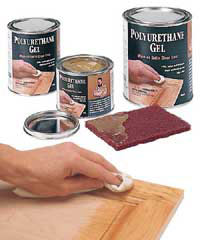
A woodworker is currently using polyurethane for his finishing and doesn’t like the results. He uses light coats and steel wool between coats, but it still looks wavy and full of ridges. He wants advice on other finishes so he can get high gloss with a deep finish, even if it means a lot more work.
Michael Dresdner: I’m going to assume you started out with an entirely flat surface (a dangerous assumption, I know.) I’ll guess that you ensured flatness by sanding diagonally except for the very last grit. Sanding on the diagonal, and switching 90 degrees with each grit, will help keep the board flat and avoid washboard ridges. These ridges are common on woods whose summer and winter woods are very different densities.
If all that is so, all the waves and ridges were put in during your finishing steps. If ridges show up after your first thin coat, your wood was not flat to start with.
Afterward, use sandpaper between coats. Steel wool does not cut flat. It abrades by following the surface that is already there. Sandpaper, on the other hand, cuts flat. If you applied the finish unevenly with ‘waves and ridges,’ the steel wool will not eliminate that and will only accentuate it. If you sand flat after each coat, you will only have to contend with one coat’s uneven surface at a time. And chances are, if you are applying thin enough coats, you will not have ridges and waves ? their presence suggests that the finish is going on too heavily.
Finally, a note about gloss finishes. While it is possible to do a gloss finish in a thermoset finish, like oil based poly, it is much more difficult. That’s because when you do the final rub, you run the risk of cutting into the layer below and creating a witness line, a fine line showing where one coat ends and the next begins. For gloss rub, I prefer thermoplastic finishes, such as shellac and lacquer. Because they redissolve themselves with each coat, there is never a line that shows no matter how deeply you cut when you rub up to gloss. The good news is that it is NOT a lot more work – only a different material ? and you will not have to sand between all coats. Sand once after the first coat to eliminate any ‘fur’ and once before the final coat, to make sure your surface is flat.”





